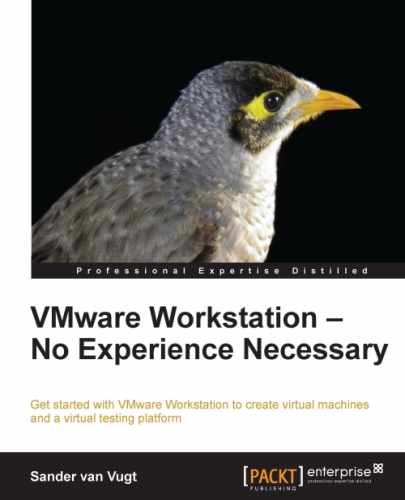You've just worked with the virtual machine options item to enable shared folders. There are some other settings that you can select from this tab. Some of the most interesting options are discussed in this section.
When working with a virtual machine, you can have a snapshot created automatically. A snapshot is like a picture of the current state of a virtual machine that allows you to go back to that specific state in an easy way. As an additional protection for virtual machines, you can have snapshots created automatically when powering off. However, using snapshots may be dangerous if you don't know what you're doing; they do use disk space and by using snapshots, you risk running out of available disk space. Also, performance will worsen if there are snapshots for your virtual machines.
To enable the automatic snapshot feature, access the Snapshots menu option and select between the following when powering off the options:
- Just power off
- Revert to snapshot
- Take a new snapshot
- Ask me
Notice that the Revert to snapshot option is a potentially dangerous option; it will reset your virtual machine to the state it was in when the last snapshot was created, and you will lose all the changes that you've made since.
The AutoProtect feature that you can also find in the virtual machine's Options menu is related to snapshots. You can use this feature to automatically create snapshots according to the parameters that you've specified. This is a useful feature that always allows you to get back to a reasonably recent state of the virtual machine.

When using AutoProtect, you're sure that you can always revert to a recent state of the virtual machine
In virtualized environments, time keeping may be a problem. This is because time is based on CPU ticks, and in a VMware Workstation virtual environment, virtual machines don't use CPU ticks the way normal computers do. Therefore, you might see huge time drifting if you don't take the appropriate measures. At the other end, time synchronization is essential because many services rely on the appropriate time.
On the VMware Tools menu option, you'll find an interesting option as well. This option specifies whether you want to use time synchronization or not. By default, the virtual machine doesn't synchronize time with the host. Because of virtual machine's inherent features, this may lead to a time that significantly differs from the real time. To avoid issues, it is a good idea to have the virtual machine synchronize time with the host and to configure NTP time synchronization on the host, which ensures that a reliable time is used on the host as well.
To access a virtual machine, you can configure remote access within the Virtual Machine itself. If, however, you're looking for a more standard method of enabling remote access which works for all virtual machines, no matter which operating system you're using, VNC connections is an interesting option. With VNC, you'll share access from the VMware Workstation host to the entire virtual machine screen. The benefit of this approach is that you can use it to access all virtual machines no matter what operating system is running inside. There is an inconvenience to using VNC though; data that is sent over a VNC connection is not encrypted by default. This means you should only use it to access virtual machines that are on a network connection which you trust completely.
To enable a VNC access to virtual machines, you need to select the Enable VNC connections option on each virtual machine (VM) where you want to use it. Next, you'll need to specify a VNC Port. Every VNC connection will use its own port, so you might end up with one VNC process that is listening on several ports on your host and that is fine. It's also a very good idea to protect each VNC session with a password. If you don't use a password, anyone can just connect to the active sessions on the virtual machine and that is a huge threat to security!
After setting up VNC for virtual machines, you'll need to make sure that you have a VNC client on the remote computer. Different VNC clients are available for free, and you can find one on, for instance, www.realvnc.com.
